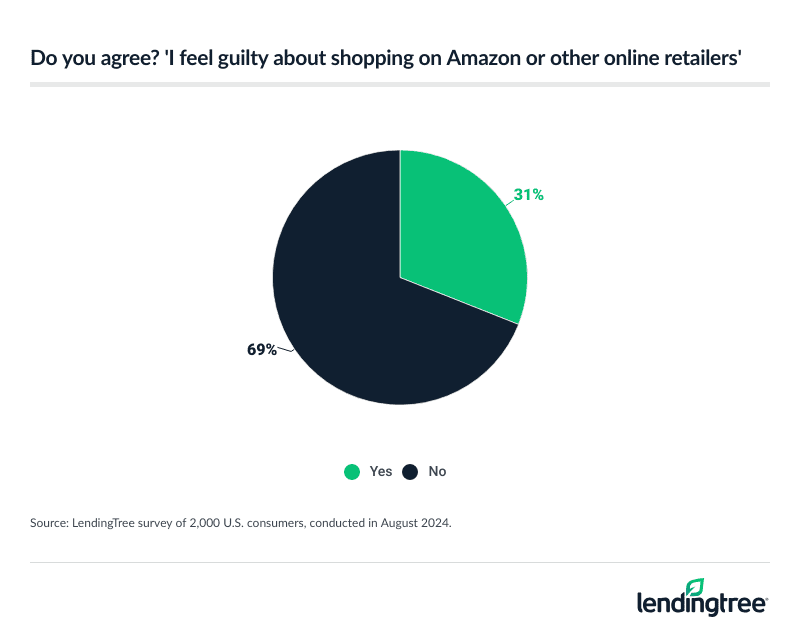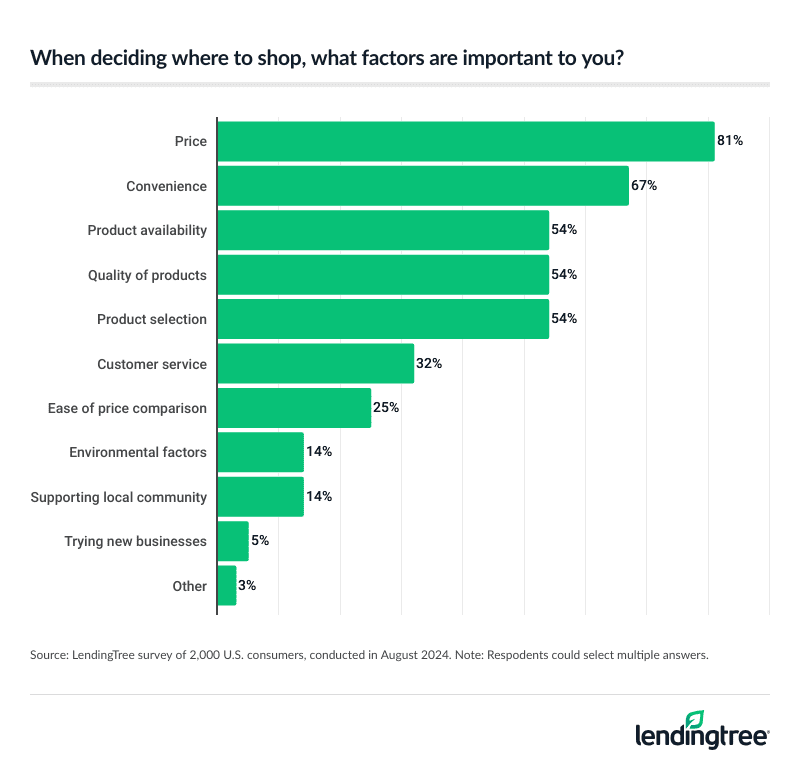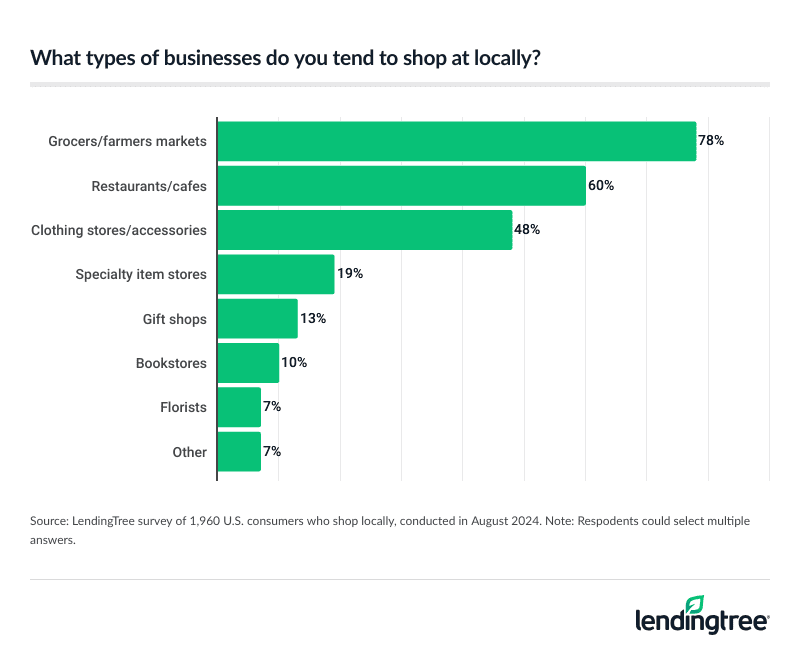Nearly 2 in 3 Americans Wish They Could Shop Local More, but They’re Held Back by Price and Convenience
Shop local? Sure. Most Americans are on board with supporting their community by patronizing local businesses … at least in theory. In practice, they don’t do it as much as they wish.
The latest LendingTree survey finds more than 9 in 10 Americans shop local at least once a month, with more than 7 in 10 doing so at least weekly. However, 65% say they would shop local more often but cost, convenience and product selection sometimes cause them to take their dollars elsewhere.
Read on for more about Americans’ local shopping habits and their guilt.
Key findings
- Most Americans believe in shopping local, but it’s not always realistic. An overwhelming 90% of Americans believe shopping locally positively impacts their community, and 65% wish they could shop locally more than they do. When asked what’s holding them back, 57% said cost, 42% said convenience and 39% said product selection.
- Nearly 3 in 4 Americans utilize Amazon or online-only retailers monthly, though it comes with guilt for some. 71% of consumers order from these retailers at least monthly. However, 31% feel guilty when they shop at these retailers, led by 45% of Gen Zers. Additionally, among the 29% who say they’re morally opposed to shopping at Amazon, 85% do it anyway.
- Price is the biggest factor for most shoppers. Overall, 80% of respondents say inflation is making it more difficult to shop locally, and 75% wish they could afford to patronize their local businesses more than they do. When asked about the most important factors when shopping, 81% answered price, followed by convenience at 67%.
- Plenty of Americans do their part to help local businesses. Half of Americans are willing to spend more to shop local. When local shoppers were asked what businesses they most commonly utilize, 78% said grocers or farmers markets, 60% said restaurants or cafes and 48% said clothing stores. Overall, 70% say they try to source food locally.
Most Americans believe in shopping local, but it’s not always realistic
Americans want to shop local, and many do so regularly. In fact, 92% of Americans shop local at least monthly. Broken down, 57% say they shop local weekly, 20% monthly and 15% daily. Only 2% say they never shop local, and the rest (6%) do so only a few times a year.
Who shops local most frequently? The younger generations lead the charge. Nearly 1 in 4 (24%) Gen Zers ages 18 to 27 report doing so daily, followed by 19% of millennials ages 28 to 43, 12% of Gen Xers ages 44 to 59 and 5% of baby boomers ages 60 to 78. Men are also more likely than women to shop locally daily — 18% versus 11%, respectively.
Nearly all (90%) respondents believe shopping local positively impacts their community, and 65% say they wish they could do so more frequently.
So what’s holding back those who wish they could shop local more? Here are the top roadblocks respondents cite:
- Price: 57%
- Convenience: 42%
- Product selection: 39%
- Product quality: 26%
- Customer service: 16%
- Environmental factors: 14%
Matt Schulz — LendingTree chief consumer finance analyst and author of “Ask Questions, Save Money, Make More: How to Take Control of Your Financial Life” — says it’s understandable some people don’t shop local as much as they’d like. However, if it’s important to you, it’s worth finding ways to do so within your means.
“Especially when life is as expensive as in 2024, sometimes the only thing that matters in your decision is the cost, and that’s OK,” he says. “That said, spending should also reflect your values. There are plenty of cases in which getting the best price isn’t the No. 1 priority, and one of those situations is spending to support something you believe in. Shopping locally and supporting small businesses can be an example of that.”
71% utilize Amazon/online-only retailers monthly, some with guilt
Online shopping is so easy from the comfort of your couch, and the prices can be hard to beat. But the guilt can be difficult to beat, too.
Ordering goods on Amazon or other nonlocal online retailers makes many consumers feel guilty. While 71% of consumers order from these retailers at least monthly, 31% say they feel guilty when they do. Gen Zers feel the most guilt (45%, compared with 20% of baby boomers), and men feel slightly more guilty about it than women — 33% versus 29%, respectively.
Those with the highest household incomes have more guilt about shopping online than those who make the least. In fact, 40% of those who make $100,000 or more a year report it weighing on their conscience, versus 24% of those who make under $30,000. And those with children under 18 (39%) are more likely to feel guilty than those with children 18 or older (21%) or those with no children (30%).

“People feel guilty because they know that many small, local businesses have struggled to compete with Amazon and the onslaught of online retailers,” Schulz says. “They value small businesses and know how important a part of the community they are, but shoppers also feel conflicted because they’re struggling, too. Their financial wiggle room is tiny, making them very price-conscious.”
And what’s a little moral opposition? It’s not enough to stop some people from shopping at Amazon. Among the 29% who say they’re morally opposed to shopping at Amazon, 85% do it anyway.
As for the environmental impacts of shopping online, less than half of Americans (43%) consider them. The younger generations are more likely to than the others, however — 53% of Gen Zers and 50% of millennials, versus 38% of Gen Xers and 30% of baby boomers. Also, those with children under 18 are more likely to consider the environmental impacts of shopping online (55%) than those with children 18 or older (33%) or those with no children (39%).
Another competitor to local businesses? Big-box retailers, where 76% of Americans say they shop at least monthly.
Price is biggest factor for most shoppers
So what makes Americans put their shop-local ideals aside? Price is the main deterrent, and 80% say inflation has made it more difficult to shop locally. Women feel this more strongly than men — 83% versus 78%, respectively — while baby boomers (74%) feel it less strongly than their younger counterparts:
- Gen Zers (81%)
- Millennials (83%)
- Gen Xers (83%)
“Inflation has made people very sensitive to price, whether the prices are charged by small businesses, large businesses or anyone else,” Schulz says. “That price sensitivity has forced many people to make difficult decisions about where to shop and what to buy. For many, that has led them to spend less locally, even though they’re not happy about it.”
The desire is there, though. Among all Americans, 75% say they wish they could afford to shop local more than they do. Those with children under 18 feel this the most — 82%, compared with 72% of those with children 18 or older and 71% of those with no children. And more women than men say they wish they could afford to — 77% versus 73%, respectively.
For many, it comes down to price, which is the biggest driver for Americans deciding where to shop.
When asked which factors are important when determining where to drop their dollars, 81% said price. That was followed by convenience (67%) and product availability, product quality and product selection — each chosen by 54% of respondents. Only 14% said supporting their local community is an important factor.

Plenty of consumers do their part to help small businesses
Even though price is a pressing matter, 50% of shoppers say they’re willing to spend more to support local businesses. Men are more willing than women — 56% versus 44%, respectively. And the youngest generations are more willing than their older counterparts — 57% of millennials and 56% of Gen Zers, versus 44% of Gen Xers and 42% of baby boomers.
Interestingly, those who make the most ($100,000 or more) are significantly less willing to spend more to support local businesses than those who make the least (under $30,000) — 38% versus 57%.
As for what types of businesses local shoppers support, grocers and farmers markets top the list, with 78% saying they tend to shop at them. That makes sense, as more than two-thirds of Americans say they try to source their food locally. Grocers and farmers markets are followed by restaurants and cafes (60%) and clothing stores/accessories (48%).

5 tips to save money while shopping locally
It may take a bit more effort, but it’s possible to shop local while still staying on budget. These tips can help you save money while supporting your community and shopping guilt-free.
- Shop around. Shopping locally doesn’t have to mean shopping in a more expensive way. Taking the time to comparison shop, even among local businesses, is almost always a good idea. If you don’t do it, you’re probably spending too much, and that’s the last thing anyone needs to do right now.
- Let credit card rewards help. The right credit card, used wisely, can save you money. That extra 1% or 2% cash back may not sound like much, but it can add up to save you significant money.
- Stay seasonal. When it comes to food, prices are generally better for in-season items. Plan your meals according to what’s in season in your area so you can take advantage of not just what will be the freshest but also what will likely be the best deals financially.
- Keep in touch. Follow your local businesses on social media and sign up for their email lists. Often, they’ll promote sales and special deals, so you’ll know the best times to buy for budgeting. They may also send out coupons or offer discounts to their followers around holidays or special occasions.
- Join loyalty programs. Some businesses offer rewards that accrue when you make purchases. For example, a local coffee shop may offer a free coffee after purchasing five. Signing up is typically simple and free, and the savings can add up.
Methodology
LendingTree commissioned QuestionPro to conduct an online survey of 2,000 U.S. consumers ages 18 to 78 from Aug. 12 to 14, 2024. The survey was administered using a nonprobability-based sample, and quotas were used to ensure the sample base represented the overall population. Researchers reviewed all responses for quality control.
We defined generations as the following ages in 2024:
- Generation Z: 18 to 27
- Millennial: 28 to 43
- Generation X: 44 to 59
- Baby boomer: 60 to 78
Compare business loan offers
- Key findings
- Most Americans believe in shopping local, but it’s not always realistic
- 71% utilize Amazon/online-only retailers monthly, some with guilt
- Price is biggest factor for most shoppers
- Plenty of consumers do their part to help small businesses
- 5 tips to save money while shopping locally
- Methodology
Read More
43 Eco-Friendly Business Ideas Updated April 26, 2024 If you want to start an eco-friendly business, these green business ideas could help the…Read More
As National Mom and Pop Business Owners Day Approaches, Here Are 4 Ways to Show Support Updated February 27, 2023 National Mom and Pop Business Owners Day falls on March 29. In honor of this…Read More

